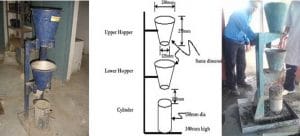Compaction Factor Test: Its Apparatus, 8 Procedure Steps & Advantages
The compaction factor test is used to calculate the degree of workability of fresh concrete with regard to the internal energy required for computing the concrete perfectly.
In the UK by Glanville in 1947 compaction factor tests were developed and the degree of compaction is measured by it. This test will give a reasonably reliable assessment of the workability of concrete and the test require measurement of the weight of the partially and fully compacted concrete and also the ratio of the partially compacted weight to the fully compacted weight.

The compacting factor lies between 0.8 to 0.92 for the normal range of concrete.
For concrete which has low workability for which slump test is not suitable then the compaction factor test is used and this test is conducted in the laboratory.
Apparatus for Compaction Factor Test:
- Compaction Factor Machine
- Weighing Machine & Compacting Rod
- Mechanical Vibrator or Steel Trowel.

The apparatus consists of trowels, a hand scoop which is 15.2 cm long, a balance, and a rod of steel which is 1.6 cm in diameter, and 61 cm long rounded at one end.
In the laboratory, the concrete mix is prepared as per design.
The Procedure of Compaction Factor Test:
There are the following steps in the procedure as given below;
- By using the hand scoop, place the concrete sample gently in the upper hopper to its brim and level it and then cover the cylinder.
- At the bottom of the upper hopper, open the trapdoor so that concrete falls into the lower hopper and with the rod, push the concrete sticking on its sides gently.
- To fall into the cylinder below, open the trapdoor of the lower hopper and allow the concrete to fall.
- By using trowels, cut off the excess concrete above the top level of the cylinder and level it, then clean the outside of the cylinder.
- To the nearest 10g weight, the cylinder with concrete and this weight is called the weight of partially compacted concrete as W1.
- Empty the cylinder and then with the same concrete mix in layers approximately 5 cm deep refill it to obtain full compaction, each layer has to be heavily rammed.
- Level the top surface and then weigh the cylinder with fully compacted which is known as the weight of fully compacted concrete as W2.
- Then as W, find the weight of the empty cylinder.
Calculations:
By dividing the value of partially compacted concrete by the value of fully compacted concrete, the compaction factor is calculated and to the nearest second decimal place, it shall normally be stated.
Compaction factor = (W1-W) / (W2-W)
Conclusion:
The compaction factor of the concrete is found to be = …….
From 0.7 to 0.95 is the range of compaction factor values.
Compaction Factor Value | Standard of Workability |
| 0.95 | Good |
0.92 | Medium |
| 0.85 | Low |
Advantages of Compaction Factor Test:
There are the following advantages of the compaction factor test such as;
- In laboratories, suitable for testing workability.
- For concrete with low workability, this test is suitable.
- Over a wide range, it is suitable to detect the variation in workability.
- As compared to the slump test, the compaction factor test gives more information that is about compatibility.
- This test is more appropriate than static tests for highly thixotropic concrete mixtures and is a dynamic test.
- More precise and sensitive results.
Disadvantages of Compaction Factor Test:
There are the following disadvantages of this test;
- Reduces its usefulness in the field due to the large and bulky nature of the device.
- To measure the mass of the concrete in the cylinder, the test method requires a balance.
- This test method does not use vibration and although the test is commercially available and used rarely.

